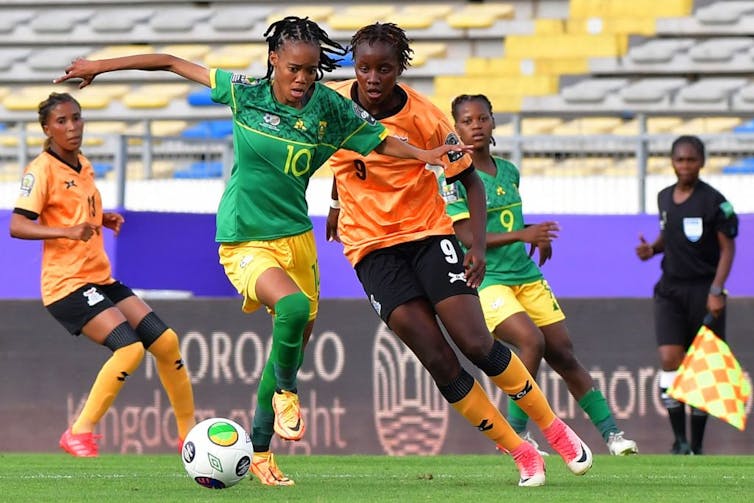lr) Linda Motlhalo, Thembi Kgatlana, and Gabriela Salgado of Banyana Banyana. (ANP via Getty Images)
This weekend’s Women’s African Football Championship (Wafcon) final between Morocco and South Africa in Morocco marks a new era. With it women’s football in Africa has reached a second phase of its development.
If the first phase was about the rise of a few superpowers, led by Nigeria, then the new phase is about a spread of teams rising to the top as development of the game takes hold on the continent.
Wafcon is the women’s Afcon, the biggest national tournament on the continent, held every two years. The championship final is between two teams that have never won the trophy, which has previously been dominated by Nigeria, who won 11 of the 13 Wafcon tournaments to date including the inaugural one in 1991. South Africa beat Zambia and Morocco beat Nigeria to set up the final.
And these top four Wafcon teams also automatically qualify for the Women’s World Cup final stage in Australia and New Zealand in 2023.
Two of these – Morocco and Zambia – will be representing the continent for the first time at the world’s premier football event, held every four years. This, along with their success at Wafcon, tells the story of how the women’s game continues to develop apace in Africa despite the challenges.
The first phase
Football was introduced in Africa as a colonial sport. While women in Nigeria, for example, were recorded playing the sport in the 1930s, they were discouraged from doing so. By the 1970s and 1980s competitive women’s clubs began emerging.
The first phase of the development featured first movers such as Nigeria, Ghana, Cameroon and South Africa. These countries used early growth of their local women’s football in the 1990s and 2000s to establish an advantage over the rest of the continent.
Playing regularly in the local leagues provided the competition and fitness necessary to dominate at that stage. While Nigeria began to win the continental trophy regularly, from 1991, it was challenged by Ghana, Equatorial Guinea, Cameroon, and South Africa with intermittent success.
However, with more national federations paying more attention to women’s football, the early success of the first movers is amply challenged as the continent moves into the second phase of women football development. That challenge has been dependent on mining overseas talent as well as developing local women’s league football.
 South Africa (in green and gold) beat Zambia in the Wafcon semi-final. (AFP via Getty Images)
South Africa (in green and gold) beat Zambia in the Wafcon semi-final. (AFP via Getty Images)
The result is that Nigeria will be absent in the finals for the first time in Wafcon history. Some will argue that it took the disqualification of two of the country’s players and a penalty-kick tiebreaker in the semi-final against Morocco to deny them another place at the championship game. However, this is beside the point. What matters is that the Moroccans deserve a place in the final after playing attractive possession football throughout the tournament.
The story of Zambia and Morocco underlines the second phase of development of women’s football in the continent.
The second phase
Critically, African countries with players overseas have moved to harvest and use these resources. For example, North African countries such as Tunisia, Algeria and Morocco, with substantive nationals residing in places like France and Spain, have taken advantage by recruiting eligible players from there. The French national women’s team finished in the top eight teams at the 2019 Women World Cup. It is a team with several players linked to North African parentage.
Zambia, without their best player Barbara Banda, was dealing with a handful at this tournament. The team has players playing in China, Turkey, Kazakhstan and Spain. Senegal has six players who play in France.
While both Zambia and Senegal do not have many players based outside their homeland, they have developed players in one or two local clubs that create the needed chemistry for building solid teams. Zambia draws its players largely from clubs like Green Buffaloes FC, Red Arrows and ZESCO United. These clubs also have popular male teams.
Ultimately, Wafcon 2022 signals the early stage of the second phase of women’s football development in the continent.
The long-term challenge is developing these teams to match the strength of the rest of the world. Nigeria, at 39th is the highest ranked African women’s team in the world. Two decades ago they were ranked 23rd and it appears that the rest of the world is developing women’s football much faster than Africa is.
Chuka Onwumechili, Professor of Communications, Howard University
This article is republished from The Conversation under a Creative Commons license. Read the original article.